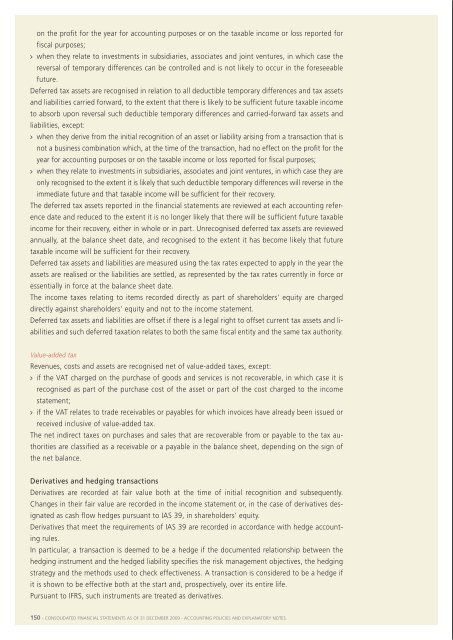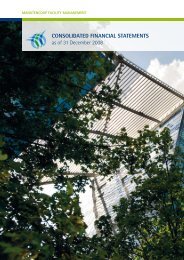Financial Statements 2009 - Manutencoop
Financial Statements 2009 - Manutencoop
Financial Statements 2009 - Manutencoop
Create successful ePaper yourself
Turn your PDF publications into a flip-book with our unique Google optimized e-Paper software.
on the profit for the year for accounting purposes or on the taxable income or loss reported forfiscal purposes;> when they relate to investments in subsidiaries, associates and joint ventures, in which case thereversal of temporary differences can be controlled and is not likely to occur in the foreseeablefuture.Deferred tax assets are recognised in relation to all deductible temporary differences and tax assetsand liabilities carried forward, to the extent that there is likely to be sufficient future taxable incometo absorb upon reversal such deductible temporary differences and carried-forward tax assets andliabilities, except:> when they derive from the initial recognition of an asset or liability arising from a transaction that isnot a business combination which, at the time of the transaction, had no effect on the profit for theyear for accounting purposes or on the taxable income or loss reported for fiscal purposes;> when they relate to investments in subsidiaries, associates and joint ventures, in which case they areonly recognised to the extent it is likely that such deductible temporary differences will reverse in theimmediate future and that taxable income will be sufficient for their recovery.The deferred tax assets reported in the financial statements are reviewed at each accounting referencedate and reduced to the extent it is no longer likely that there will be sufficient future taxableincome for their recovery, either in whole or in part. Unrecognised deferred tax assets are reviewedannually, at the balance sheet date, and recognised to the extent it has become likely that futuretaxable income will be sufficient for their recovery.Deferred tax assets and liabilities are measured using the tax rates expected to apply in the year theassets are realised or the liabilities are settled, as represented by the tax rates currently in force oressentially in force at the balance sheet date.The income taxes relating to items recorded directly as part of shareholders’ equity are chargeddirectly against shareholders’ equity and not to the income statement.Deferred tax assets and liabilities are offset if there is a legal right to offset current tax assets and liabilitiesand such deferred taxation relates to both the same fiscal entity and the same tax authority.Value-added taxRevenues, costs and assets are recognised net of value-added taxes, except:> if the VAT charged on the purchase of goods and services is not recoverable, in which case it isrecognised as part of the purchase cost of the asset or part of the cost charged to the incomestatement;> if the VAT relates to trade receivables or payables for which invoices have already been issued orreceived inclusive of value-added tax.The net indirect taxes on purchases and sales that are recoverable from or payable to the tax authoritiesare classified as a receivable or a payable in the balance sheet, depending on the sign ofthe net balance.Derivatives and hedging transactionsDerivatives are recorded at fair value both at the time of initial recognition and subsequently.Changes in their fair value are recorded in the income statement or, in the case of derivatives designatedas cash flow hedges pursuant to IAS 39, in shareholders’ equity.Derivatives that meet the requirements of IAS 39 are recorded in accordance with hedge accountingrules.In particular, a transaction is deemed to be a hedge if the documented relationship between thehedging instrument and the hedged liability specifies the risk management objectives, the hedgingstrategy and the methods used to check effectiveness. A transaction is considered to be a hedge ifit is shown to be effective both at the start and, prospectively, over its entire life.Pursuant to IFRS, such instruments are treated as derivatives.They are initially recognised at their fair value on the arrangement date; subsequently, such fairvalue is re-measured on a periodic basis. They are recorded as an asset if fair value is positive andas a liability if fair value is negative.Any gains or losses deriving from changes in the fair value of derivatives that are unsuitable forhedge accounting purposes are reflected directly in the income statement for the year.Segment reportingThe risks and profitability of the Group are mainly affected by differences between the types ofservice provided; accordingly, the primary breakdown of the Group is by business segment.A business segment is a clearly identifiable group of activities and transactions, providing a seriesof related products and services that are subject to different risks and returns with respect to theGroup’s other business segments.The Group’s secondary reporting is analysed by geographical segment.A geographical segment is a clearly identifiable component of the business, providing a series ofrelated products and services that are subject to different risks and returns with respect to othersegments operating in different economic environments.The lines of business comprising the primary segment consist of the following strategic areas ofGroup operations, which coincide with the activities described in paragraph 1.1.Method of allocating costs to each segment:The Group allocates specific direct and indirect production costs to each segment.Commencing from the consolidated financial statements as of 31 December 2007, the Group alsouses appropriate cost drivers to allocate commercial and other general expenses to each segment.<strong>Financial</strong> income and expense and current and deferred taxation are not allocated to the varioussegments, while the results of investments measured using the equity method are allocated to thesegments concerned.Method of allocating assets and liabilities to each segmentAssets and liabilities are allocated to each segment in a manner consistent with the treatment ofthe various income statement captions.3. Effects of final allocation of purchase price of Integra IFM BVFinal allocation of purchase price of Integra IFM BVAs indicated at the start of note 2, during <strong>2009</strong> Group management worked on final allocation ofthe price paid to purchase Integra IFM BV on 23 December 2008. This company is the parent of acomplex group that primarily provides facility management services to medium and large-sized customers.At the time of acquisition, the entire difference between purchase cost and the fair valueof the net assets acquired was provisionally allocated to goodwill.The final purchase price allocation resulted in changes to certain accounts within the statementof financial position, with respect to their balances following the provisional allocation made. Thefollowing table compares, for the various captions concerned, the amounts recognised followingfinal allocation (column: “Final amount recognised <strong>2009</strong>”) with those recognised as of 31 December2008 following provisional allocation (column: “Provisional amount recognised 2008”) and, forcompleteness, with the initial carrying amounts (column: “Carrying amount”).150 - Consolidated financial statements as of 31 December <strong>2009</strong> - Accounting policies and explanatory notes Consolidated financial statements as of 31 December <strong>2009</strong> - Accounting policies and explanatory notes - 151








